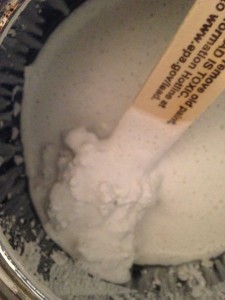 Frozen House Paint? Oh, That Can’t Be Good….
Frozen House Paint? Oh, That Can’t Be Good….
In the twenty years I have been in the house painting business, it amazes me the number of times I have run into paint cans stored in garages by folks who quite simply, have never been told NOT to.
For every person with an opinion, you will get a wide variety of answers to the question of “can I use this paint even if it has been frozen?” My opinion is a resolute NO. Why is that? The miscellaneous cans of Kilz notwithstanding, which are oil based, will not be included in this discussion. Almost without exception, the paint found in the vast majority of homes today will be of the “latex” variety, which is a water-borne dispersion of sub-micrometer polymer particles. Or, simply put, water with other stuff mixed in.
Now your garage may be a fine place to store your Bud Lite in the winter time, but a product that you put on your walls or the outside of your home will just not perform as it was produced to if the majority of its composition is water. And what happens to water when it is introduced to extreme cold?…….that’s right, class; it freezes.
I’m a few credits shy of my chemistry degree, so I can’t explain fully without sounding dull and boring, but I can tell you that when paint does freeze, the water molecules expand and change the other components of paint. The four basic elements of paint are comprised of binders, solvents, pigments and other additives, each of which are compromised once frozen.
Why does this matter? Let’s take a quick look at what each of these elements do and how it can affect the look of your home if you use that frozen paint.
Binders are also known as “the vehicle” and are responsible for how paint forms a film on a painted surface and is the reason why paint sticks to your walls. Additionally, binders have a lot to do with flexibility, durability, gloss and toughness. So to alter the chemical composition of binders means that using paint that has been frozen can potentially give you an uneven or dull finish, not to mention that it will have lower values of durability and color retention.
Solvents are most frequently associated with oil based products, but in the world of latex paints, they are the means by which the binder (polymers) are dissolved and the product achieves its desired viscosity. Additionally, they allow the paint to dry naturally as they and the water component evaporate. Any alteration of the water molecule will similarly alter the binders qualities.
Pigments are made up of either natural or synthetic fillers that allow color to be put into house paint. In the same family, fillers make paint tough, give it texture and protect a substrate (your walls) from ultraviolet rays through the use of “hiding” pigments. The result of using that old can of paint could be that the color is altered and the finish weaker. Think of your kids or grandkids rubbing against walls regularly…..
Additives are a small part of what goes into that gallon of paint, but can have an impact on its dried finish. Among the many things additives can do is to extend “wet edge” (a painters term meaning the paint does not dry too fast while being applied), and improve both the finish and pigment stability. Additives also include things like thickeners, emulsifiers, adhesion promoters, UV stabilizers and biocides (anti-bacterial, mildew-resisting agents).
So, what do you do when you drag those nasty old cans in from the garage? Do you take a chance that the small touch up won’t be a big deal, or do you call a professional in to give you the peace of mind that it gets done right and looks just the way you want it?
Oh yeah, and that closet in the basement that you are keeping Aunt Emma’s 50-year old musty, smelly quilts in? She’ll never miss them. So clear it out and put all of your paints and primers from this point forward in it and rest assured that you will never have another problem.

